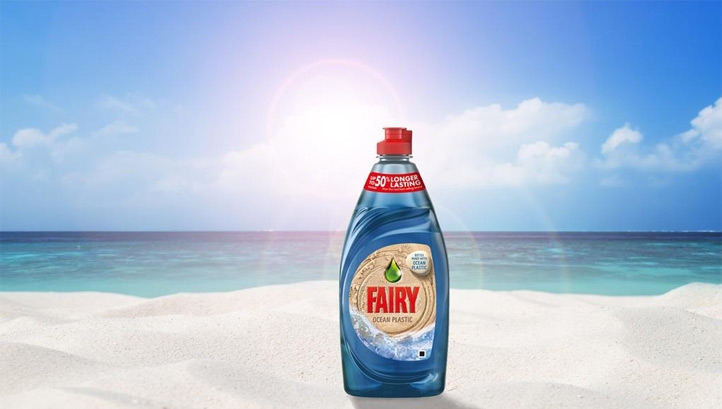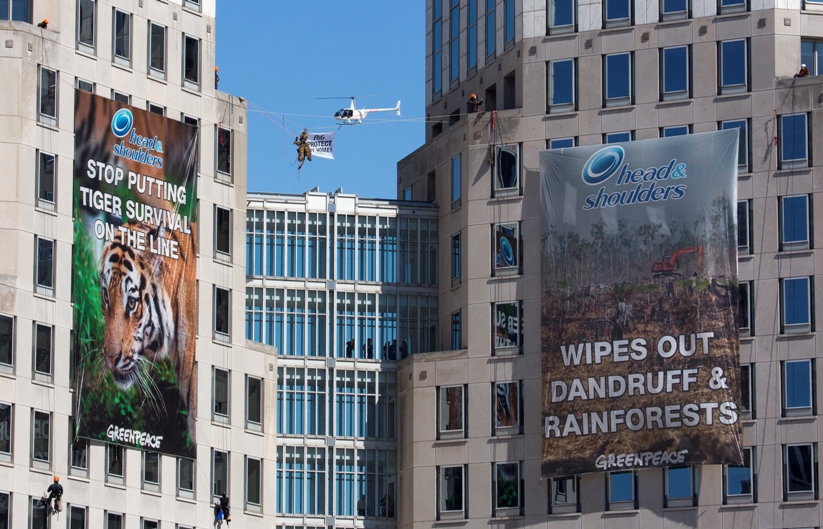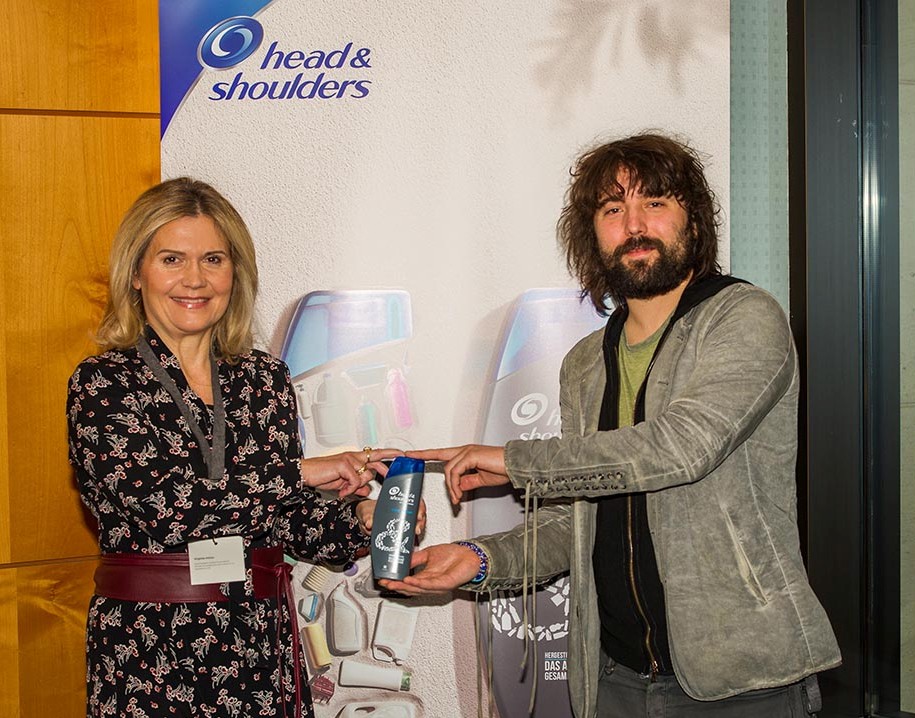Updated: The chief sustainability officer of Procter & Gamble tells Terry Slavin how the world’s biggest consumer plans to end packaging waste by 2030. The article has been updated to include a response from Greenpeace
Procter & Gamble has come a long way since Greenpeace activists unfurled giant banners down the side of its Cincinnati headquarters in 2014 accusing the Head & Shoulders shampoo maker of “wiping out dandruff and rainforests”, and demanding that it “stop putting tiger survival on the line”.
P&G’s head of sustainability, Virginie Helias, says just how far was illustrated at the World Economic Forum in Davos, when Greenpeace joined the press conference launching the Loop platform, a partnership to radically cut packaging waste, led by P&G and New Jersey waste company TerraCycle.
In pilots that will begin later this year in France and the US, hundreds of products, from deodorants to ice cream, will be delivered to customers in refillable and recyclable packaging. Consumers will be incentivised to return the packaging, which will remain the property of the consumer goods companies, by paying a small deposit, in a breathtakingly ambitious attempt to eradicate single-use packaging.
In 2014 Greenpeace were scaling our headquarters in tiger suits, now we see them supporting one of our projects
“If you’d told me a few years ago that Greenpeace would be on the same side of the table with us at the Loop press conference, I wouldn’t have believed it,” Helias says. “In 2014 they were scaling our headquarters in tiger suits, and now we see them supporting one of our projects.”
The support was not unconditional: “They were saying they support the ambition of Loop and in the same breath that it isn’t enough, and we need to scale,” but that is par for the course, Helias said.
As a target for NGO action, they don’t come much larger than P&G, the world’s biggest consumer goods company, whose products, from Fairy Liquid, to Tide and Pampers, reach 5 billion people every day.

In 2017, P&G was one of the brands targeted by Greenpeace when it did an audit of plastic packaging washing up on Asian beaches.
“The role of Greenpeace is critical,” Helias says. “It’s to keep us on our toes and to say it’s a journey and that we will never be done.”
But she points out that Loop is only the latest effort to take responsibility for its packaging. In June 2017, the company in Europe partnered with TerraCycle and French waste company Suez to launch its Head & Shoulders “beach plastics” bottle, high-density polyethylene (HDPE) made of 25% recycled beach plastics, which the company said produces 60% less CO2 emissions compared with using virgin HDPE. A couple of months later it followed with a beach plastic Fairy Liquid bottle, made of 10% beach plastics and 90% recycled post-consumer waste.
It's important we do the scale piece and consumer awareness piece at the same time
Helias said the two bottles were aimed at raising consumer awareness of both ocean plastics and the need to recycle packaging in the bathroom.
Asked whether there was a danger of being accused of greenwash with such efforts, she said the company at the same time announced that 90% of all shampoo bottles sold in Europe will contain 25% beach plastics by the end of 2019. “That’s the ‘scale’ piece,” she said. “It’s important that we do the scale piece and consumer awareness piece at the same time.”
Helias says P&G is no johnny-come-lately to the plastics issue. “We’ve been working on this for decades without talking about it.”

In April last year, P&G unveiled its Ambition 2030 sustainability plan, promising that 100% of P&G’s packaging will be recyclable or reusable by 2030, and none of its plastic packaging will find its way to the sea.
In January this year, the company’s CEO, David Taylor, was named as chairman of the newly launched Alliance to End Plastic Waste, led by the World Business Council for Sustainable Development, a partnership of nearly 30 companies in the plastics value chain, including Shell, Total, Suez, Veolia, Dow, Covestro and DSM. Together they have committed to invest $1bn-$1.5bn over the next five years to help unlock solutions to plastic waste in the environment.
Given the big names involved, $1.5bn seems a drop in the plastic-clogged ocean, but Helias said it would act as “catalytic capital”, de-risking projects to allow big institutional investors to jump in with the big dollars needed.
What’s lacking is a pipeline of investable projects that have qualified to scale. That’s the purpose of the alliance
There is no shortage of money, or innovative solutions, Helias says. “What’s lacking is a pipeline of investable projects that have qualified to scale. That’s the purpose of the alliance.”
P&G is the only consumer goods company so far represented, and Helias says she was "thrilled" when Taylor agreed to chair the alliance. “And the impact it had internally was amazing,” she says.
Helias, who opted to live in Geneva with her husband and three children rather than move to Cincinnati when she became vice president of global sustainability at P&G in 2016, speaks in a strong French accent and brings a European sensibility to her job, despite more than 30 years working for the US company.

Asked why P&G is not a signatory to Ellen MacArthur Foundation’s New Plastics Economy global commitment, which counts 250 companies, including Colgate Palmolive, Mars Inc , Nestlé, SC Johnson, The Coca-Cola Company, and Unilever, she says: “We are totally aligned with the Ellen MacArthur Foundation. The only issue is timing, and this is where P&G makes it hard for itself.”
Under the commitment, companies undertake to ensure 100% of their plastic packaging can be reused, recycled, or composted by 2025. P&G has set 2030 for the same target. “We believe we will be 95% recyclable by 2025, but not 100%. This is a small thing, but for us it is very important. We don’t put things out there that we know we won’t be able to deliver.”
Helias puts it down to a cultural difference between American and European companies; the former regard commitments as legally binding, while the latter are prepared to set ambitious future goals even if they don’t yet have a cast-iron plan to deliver them.
In the US, people are expecting big brands to be part of Loop while in Europe they are super-critical. They want to know there is no greenwash
Still, the more cavalier European approach may have its downsides: P&G’s research on consumer attitudes towards Loop points to striking differences in attitudes to big brands.
“In the US, people are expecting big brands to be part of Loop,” Helias says. “They want their Pampers, Tide, Cascade, Gillette [to participate in the Loop]. In Europe they are super-critical of the big brands. They want to know there is no greenwash.”
Helias had her Damascene conversion to sustainability in 2005, when she saw Al Gore’s film An Inconvenient Truth. At the time she headed up P&G’s Ariel detergent brand in Europe.

“The gravity of climate change really struck me,” she told another interviewer. “And more importantly, I discovered that … Ariel could become the single-most important driver of P&G’s carbon footprint reduction,” since 80% of its carbon footprint came from the wash temperature.
She came up with the Ariel “Turn to 30” campaign, urging consumers to wash their clothes at lower temperatures. “Thanks to the success of this project, I found my vocation. I then asked the CEO to create a position to bridge the science of sustainability with the business, which ultimately led me to my role today.”
Packaging, though important, is only one stream of Helias’s work. In her interview with Ethical Corporation, she explains that water security is also a critical issue for the consumer goods giant, with 70% of P&G products requiring water in their use.
What we need to do now is develop a strategy for partnership and funding, just as we do with plastic waste
The Ambition 2030 document promises a 35% increase in water efficiency (compared with 2010) and to source at least 5 billion litres of water, 10% of its water consumption, from circular sources.
In pursuit of this, P&G has been working with The Nature Conservancy, WWF and the World Resources Institute to identify 18 priority water basins and develop a water risk assessment mapping process.
“What we need to do now is develop a strategy for partnership and funding, just as we do with [plastic] waste,” Helias says, promising a big announcement on water next year. “We want to show the same kind of leadership [as with plastics] and be the catalyst on water stewardship.”

This sits a bit uneasily with the latest report from CDP on the preparedness of consumer goods companies for the low-carbon transition, which ranked P&G second last in its category among houshold goods firms. Christie Clarke, research analyst at CDP, said while the company was "actively innovating" around some of its major brands, it should be doing more to manage emissions from its biggest sellers. She also said it should set a formal target to reduce emissions in its value chain (Scope 3). (see "Companies aren’t moving fast enough on the circular economy")
Asked in an email about the CDP report, Helias said: "Climate change is a key priority for P&G and we have significant efforts under way. This includes driving progress against our science-based goal to cut our greenhouse gas emissions in half, achieving 100% renewable electricity, and helping consumers reduce their own emissions by providing detergents that deliver outstanding performance in cold water. We have significant and comprehensive efforts under way to address Scope 1, 2 and 3 emissions.
But what is P&G doing to address deforestation, the issue highlighted by Greenpeace in its 2014 stunt at P&G’s headquarters?
While P&G reports to CDP on its energy and water risk, earning B and B-, respectively, last year, it does not report on its efforts to address deforestation risk in its supply chain. But it is notable that in its Moment of Truth report last year Greenpeace praised P&G as one of eight big brands to publicly list its palm oil suppliers, all of them RSPO-certified.
These products have been part of the problem; we want them to be part of the solution
Helias points out that no consumer goods company is going to meet commitments to end deforestation in supply chains by 2020, “but we [P&G] have steps to get there, and we are working with suppliers to make sure they have zero deforestation.”
She talks enthusiastically about a P&G programme teaching 2,000 smallholder palm oil farmers in Malaysia more sustainable agriculture techniques, which has resulted in a 30%-50% increase in yields with far less fertiliser use. The project will be expanded to reach up to 10,000 farmers over the next five years.
It’s the kind of thing Helias clearly relishes: using P&G’s relationship with thousands of suppliers and 5 billion consumers to try to do some good in the world, or at least less harm. As she said in a recent TED Talk after the launch of the Head & Shoulders beach plastic bottle: “These products have been part of the problem; we want them to be part of the solution.”
Greenpeace reponse
Greenpeace USA Oceans Campaign Director John Hocevar said Greenpeace's position had been "mis-stated" by P&G and asked for it to be clarified: “Procter & Gamble is one of the world’s largest producers of single-use plastic packaging. The vast majority of this plastic ends up in landfills, incinerators, and our oceans and neighborhoods. Yet the company continues to use recycling and end of pipe approaches as a crutch. The most urgent step needed from Procter & Gamble is to set ambitious targets to reduce its plastic footprint.
“The Alliance to End Plastic Waste is a desperate attempt to keep plastic use alive. Procter & Gamble’s CEO is leading this industry effort to maintain status quo on plastics alongside fossil fuel companies that share a stake in its continued use. And while the Loop initiative has the potential to move the needle toward reuse, it needs to be prioritised and dramatically scaled up as part of a comprehensive plan to reduce the company’s overall use of single-use plastic. Reuse systems need to be accessible for everyone, affordable, and match the scale of the pollution crisis.
“We share the goal of ensuring that plastic does not enter the ocean, but do not see a path to meeting that goal until P&G reduces the vast amount of plastic packaging it puts out into the world each year.”
Diana Ruiz, Greenpeace Senior Palm Oil Campaigner, added: “P&G suppliers still have a long way to go to comply with its “no deforestation” commitment. Its suppliers are still destroying forests. In light of the recent UN biodiversity crisis report, showing 1 million species are facing extinction, there are 1 million reasons why P&G needs to take radical transformative action in order to stop being part of the problem.”
Main picture credit: Twitter
This article is part of the in-depth Circular economy briefing. See also:
To rise to the climate emergency we have to turn off the tap on waste
From refilling and sharing to recyclable thin film: the cutting edge on circular
Australian university pioneers urban mining ‘microfactories’
Beyond recycling: Putting the brakes on fast fashion
The battle to turn the tide on the e-waste epidemic
Tata’s push to reinforce steel’s circular economy credentials
‘Companies aren’t moving fast enough on the circular economy’
Greenpeace CDP P&G Ariel Loop TerraCycle Fairy Liquid water risk deforestation

